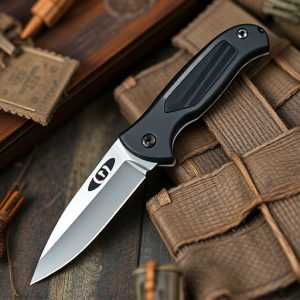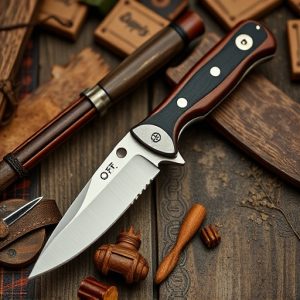Mastering the OTF Automatic Knife: Insights, Mechanics, and Legalities
Out The Front (OTF) automatic knives are advanced cutting tools ideal for everyday carry (EDC), off…….
Out The Front (OTF) automatic knives are advanced cutting tools ideal for everyday carry (EDC), offering a rapid and hands-free blade deployment through a sophisticated sliding mechanism. These knives are precision-engineered with ergonomic designs, making them suitable for practical tasks, self-defense, and serving as a modern essential for those prioritizing utility and safety. Despite their growing popularity, it's crucial to be aware of the legal distinctions and regulations that govern OTF automatic knives, which vary by region in the United States, with federal laws classifying them as "any other weapon" (AOW) under the National Firearms Act and Gun Control Act. Prospective owners must navigate complex state and local laws to ensure legal compliance. The evolution of OTF knives reflects a commitment to innovation, with advancements in materials and design enhancing their durability, reliability, and safety over time. Regular maintenance is key to preserving the knife's functionality and ensuring user safety, with routine cleaning, lubrication, and practice in safe deployment techniques being essential practices for OTF automatic knife users.
Explore the intricate world of the out the front, or OTF, automatic knife, a cutting-edge addition to the everyday carry (EDC) community. This article delves into the mechanics, legality, and evolution of OTF knives, offering insights for maintaining and operating them effectively. From their innovative design to the stringent regulations that govern them, unravel the layers of functionality and compliance surrounding these modern tools. Whether you’re a seasoned collector or a curious newcomer, this guide will equip you with the knowledge to appreciate and utilize your OTF automatic knife responsibly and efficiently.
Understanding the OTF Automatic Knife: A Modern Pioneer in Everyday Carry
An OTF, or Out The Front automatic knife, represents a cutting-edge innovation in the realm of everyday carry (EDC) items. Unlike its manual counterparts, the OTF knife features a blade that deploys automatically upon activation, offering swift and reliable access to a sharp edge. This design not only enhances the speed at which one can deploy the knife but also ensures that the user’s hands remain free for other tasks. The mechanical intricacies of an OTF automatic knife are a blend of precision engineering and ergonomic design, making it a versatile tool for both utility and defense purposes.
The OTF automatic knife has become increasingly popular among those who appreciate the seamless integration of functionality and ease of use. Its distinctive sliding mechanism is not only aesthetically pleasing but also serves as a safety feature by keeping the blade enclosed until intentional deployment is required. The legal status of OTF knives varies by jurisdiction, making it imperative for users to be well-versed in their local laws regarding EDC items. The knife’s reputation as a modern pioneer in its category is solidified by its durability, efficiency, and the innovative approach it brings to everyday carry solutions. Whether for practical tasks or as a backup in potentially dangerous situations, the OTF automatic knife has established itself as a reliable companion for those who value both utility and safety in their EDC setup.
The Mechanics Behind OTF Automatic Knives: How They Work
OTF, or Out The Front, automatic knives represent a fascinating subset within the realm of cutting tools. These mechanisms combine both simplicity and sophistication in their design and function. When activated, an OTF knife extends its blade from the handle with a smooth, fluid motion, typically propelled by a compressed spring or a series of gears known as a bias system. The deployment is usually initiated by a thumb stud or a slide switch located on top of the handle, which, upon pressure, triggers the internal mechanism to release the blade swiftly and with precision.
The engineering behind OTF automatic knives involves a carefully calibrated set of components, including springs, pivots, and bearings, all working in harmony to ensure a reliable and consistent deployment and retraction of the blade. The blade itself is often made from durable materials such as stainless steel or titanium, ensuring both longevity and sharpness. The automatic nature of these knives eliminates the need for manual thumbing or flipping to extend the blade, offering a seamless user experience that is both intuitive and efficient. This design not only streamlines the process of deploying the knife but also enhances safety by keeping the sharp edge concealed until activation. Understanding the mechanics behind OTF automatic knives allows users to appreciate their functionality and the technical prowess required to engineer such a precise and reliable tool.
Legal Considerations and Regulations Governing OTF Automatic Knives
The legal landscape governing the possession and use of OTF automatic knives is a complex tapestry woven from federal, state, and local statutes. At the federal level in the United States, the National Firearms Act of 1934 and the Gun Control Act of 1968 provide regulations that include specific provisions for automatic knives. Under these acts, OTF automatic knives are classified as “any other weapon” (AOW), which requires individuals to adhere to stringent registration and taxation procedures should they wish to legally own such a knife. It is imperative for prospective owners to familiarize themselves with these federal regulations, as non-compliance can lead to severe legal consequences.
On a state and local level, the laws governing OTF automatic knives can vary significantly. Some states may allow open carry of these knives with no restrictions, while others may prohibit their possession entirely. Local ordinances can further complicate matters by imposing their own sets of rules that either align with or diverge from state statutes. It is essential for individuals to research and understand the specific laws applicable to their jurisdiction. This due diligence is crucial as the legal status of OTF automatic knives can change with new legislation, highlighting the importance of staying informed about current regulations. Potential owners should also be aware that certain activities involving OTF automatic knives, such as brandishing or using them in a manner inconsistent with state self-defense laws, can lead to arrest and prosecution. Compliance with all applicable laws is not just a matter of legality but also a question of personal safety and responsibility.
The Evolution of the OTF Automatic Knife: From Concept to Reality
The concept of an Out-the-Front (OTF) automatic knife has undergone a remarkable transformation since its inception, marking a significant milestone in the evolution of modern knives. Initially conceived as a novel mechanism for rapid deployment of a blade, the OTF design has seen numerous iterations and advancements, driven by both technological innovation and the evolving needs of users across various sectors. Early models showcased the rudimentary principles of the OTF system, where a sprung inner liner, when actuated, pushes the blade out of its housing with a swift motion. Over time, manufacturers have refined this mechanism, enhancing durability, reliability, and safety, making the OTF automatic knife a practical tool for everyday use as well as specialized applications. The evolution of the OTF knife has been characterized by improvements in materials, precision engineering, and ergonomic design, all of which contribute to its reputation as a versatile and efficient cutting instrument. Today, OTF automatic knives are appreciated not only for their rapid deployment feature but also for their sleek profiles, compactness, and the seamless integration of technology and functionality. Collectors and enthusiasts alike value these knives for their unique design, while professionals in fields such as law enforcement and tactical operations find them to be indispensable tools due to their swift response capability and discreet carry options. The journey from concept to reality for OTF automatic knives is a testament to human ingenuity and the relentless pursuit of innovation in tool-making and design.
Tips for Maintaining and Operating Your OTF Automatic Knife Efficiently
When it comes to maintaining and operating your OTF (One-Time-Flip) automatic knife, proper care and understanding of its mechanics are crucial for both safety and longevity. Regular cleaning and maintenance are essential to ensure the knife functions smoothly. After each use, especially if the knife has been used in a dirty or corrosive environment, gently clean the blade with a cloth dampened with warm, soapy water. Avoid using abrasive cleaners or scouring pads that could damage the finish or dull the edge. Once cleaned, lubricate the internal components and moving parts with a high-quality, non-conductive lubricant specifically designed for automatic knives. This will prevent rust and ensure a seamless operation every time you deploy the blade.
To operate your OTF automatic knife efficiently, familiarize yourself with its safety features and understand how they work. Practice deploying and retracting the blade in a controlled environment to become comfortable with the mechanism. The deployment button is typically located on the handle; press it confidently without overexertion to release the blade. When retracting, allow the blade to close under spring tension rather than forcing it closed, which can damage the internal components. Regularly check the pivot and bearings for wear and tighten or replace them as necessary. This will help maintain the knife’s optimal performance. Always keep your fingers clear of the deployment path when operating the knife to avoid any accidents. By adhering to these maintenance tips and handling your OTF automatic knife with care, you can enjoy a tool that operates efficiently and remains in excellent condition over time.


